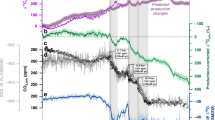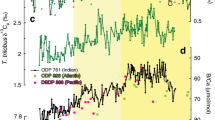Abstract
A 5-Ma record from ODP Site 1143 has revealed the long-term cycles of 400–500 ka in the carbon isotope variations. The periodicity is correlatable all over the global ocean and hence indicative of low-frequency changes in the ocean carbon reservoir. As the same periodicity is also found in carbonate and eolian dust records in the tropical ocean, it may have been caused by such low-latitude processes like monsoon. According to the Quaternary records from Site 1143 and elsewhere, major ice-sheet expansion and major transition in glacial cyclicity (such as the Mid-Brunhes Event and the Mid-Pleistocene Revolution) were all preceded by reorganization in the ocean carbon reservoir expressed as an episode of carbon isotope maximum(δ13Cmax), implying the role of carbon cycling in modulating the glacial periodicity. The Quaternary glacial cycles, therefore, should no more be ascribed to the physical response to insolation changes at the Northern Hemisphere high latitudes alone; rather, they have been driven by the “double forcing”, a combination of processes at both high and low latitudes, and of processes in both physical (ice-sheet) and biogeochemical (carbon cycling) realms. As the Earth is now passing through a new carbon isotope maximum, it is of vital importance to understand the cyclic variations in the ocean carbon reservoir and its climate impact. The Pre-Quaternary variations in carbon and oxygen isotopes are characterized by their co-variations at the 400-ka eccentricity band, but the response of δ13C and δ18O to orbital forcing in the Quaternary became diverged with the growth of the Arctic ice-sheet. The present paper is the second summary report of ODP Leg 184 to the South China Sea.
Similar content being viewed by others
References
Wang, P., Zhao, Q., Jian, Z. et al., Thirty million year deep-sea records in the South China Sea, Chinese Science Bulletin, 2003, 48(23): 2524–2535
Imbrie, J., Berger, A., Boyle, E. A. et al., On the structure and origin of major glaciation cycles, 2, the 100000-year cycle, Paleoceanography, 1993, 8: 699–735.
Clement, A. C., Seager, R., Cane, M. A., Orbital controls on the El Niño/Southern Oscillation and the tropical climate, Paleoceanography, 1999, 14: 441–456.
Petit, J. R., Jouzel, J., Raynaud, D. et al., Climate and atmospheric history of the past 420,000 years from the Vostok ice core, Antarctica, Nature, 1999, 399: 429–436.
Shackleton, N. J., The 100,000-year ice-age cycle identified and found to lag temperature, carbon dioxide, and orbital eccentricity, Science, 2000, 289: 1897–1902.
Webster, P. J., The role of hydrological processes in ocean-atmosphere interactions, Rev Geophys., 1994, 32: 427–476.
Kerr, R. A., The tropics return to the climate system, Science, 2001, 292: 660–661.
Lea, D. W., Pak, D. K., Spero, H. J. Climate impact of late Quaternary equatorial Pacific sea surface temperature variations, Science, 2000, 289: 1719–1724.
Cane, M. A., Evans, M., Do the tropics rule? Science, 2000, 290: 1107–1008.
Wang, P., Prell, W., Blum, P. et al., Proceedings of Ocean Drilling Program, Initial Reports, Volume 184, College Station: Ocean Drilling Program, 2000, 77.
Tian, J., Wang, P. Cheng, X. et al., Astronomically tuned Plio-Pleistocene benthic 18O record from South China Sea and Atlantic-Pacific comparison. Earth and Planetary Science Letters, 2002, 203: 1015–1029.
Wang, P., Tian, J., Cheng, X., Transition of Quaternary glacial cyclicity in deep-sea records at Nansha, the South China Sea, Science in China, Ser. D, 2001, 44: 926–933.
Wang, P., Tian, J., Cheng, X. et al., Carbon reservoir change preceded major ice-sheets expansion at Mid-Brunhes Event, Geology, 2003, 31: 239–242.
Schmidt, H., Berger, W. H., Bickert, T. et al., Quaternary carbon isotope record of pelagic foraminifers: Site 806, Ontong Java Plateau (eds. Berger, W. H., Mayer, L. W. et al.), Proc. ODP Sci. Results, 1993, 130: 397–409.
Shackleton, N. J., Hall, M. A., Stable isotope history of the Pleistocene at ODP Site 677 (Becker, K., Sakai, H. et al.), Proc. ODP, Sci. Results, 1989, 111: 295–316.
Mix, A., Pisias, N. G., Rugh, W. et al., Benthic foraminifer stable isotope record from Site 849 (0–5 Ma): Local and global climate changes (eds. Pisias, N. G., Mayer L. A., Janecek, T. R. et al.), Proc. ODP Sci. Results, 1995, 138: 371–412.
Shackleton, N. J., Hall, M. A., Pate, D., Pliocene stable isotope stratigraphy of Site 846 (eds. Pisias, G., Mayer, L. A., Janecek. T. R. et al.), Proc. ODP Sci. Results, 1995, 138: 337–355.
Chen, J., Farrell, J. W., Murray, D. W. et al., Timescale and paleoceanographic implications of a 3.6 Ma oxygen isotope record from the northeast Indian Ocean (Ocean Drilling Program Site 758), Paleoceanography, 1995, 10: 21–47.
Farrell, J. W., Janecek, T. R., Late Neogene paleoceanography and paleoclimatology of the northern Indian Ocean (Site 758) (eds. Weissel, J., Peirce, J., Taylor, E. et al.), Proc. OCP Sci. Results, 1991, 121: 297–355.
Raymo, M. E., Ruddiman, W. F., Backman, J. et al., Late Pliocene variation in Northern Hemisphere ice sheets and North Atlantic deep water circulation, Paleoceanography, 1989, 4: 413–446.
Tiedemann, R., Sarnthein, M., Shackleton, N. J., Astronomic timescale for the Pliocene Atlantic 18O and dust flux records from Ocean Drilling Program Site 659, Paleoceanography, 1994, 9: 619–638.
Bickert, T., Curry, W. B., Wefer, G. Late Pliocene to Holocene (2.6–0 Ma) western Equatorial Atlantic deep water circulation: Inferences from benthic stable isotopes (eds. Shackleton, N. J., Curry, W. B., Richter, C. et al.), Proc. ODP Sci. Results, 1997, 154: 239–253.
Jansen, J. F. H., Kuijpers, A., Troelstra, S. R., A Mid-Brunhes climatic event: Long term changes in global atmosphere and ocean circulation, Science, 1986, 232: 619–622.
Berger, W. H., Bickert, T., Jansen, E. et al., The central mystery of the Quaternary Ice Age, Oceanus, 1993, 36: 53–56.
Droxler, A., Farrell, J. W., Marine isotope stage 11 (MIS 11):New insights for a warm future, Global and Planetary Change, 2000, 24: 1–5.
Bassinot, F. C., Labeyrie, L. D., Vincent, E. et al., The astronomical theory of climate and the age of the Brunhes-Matuyama magnetic Reversal, Earth and Planetary Science Letters, 1994, 126: 91–108.
Rossignol-Strick, M., Paterne, M., Bassinot, F. C. et al., An unusual mid-Pleistocene monsoon period over Africa and Asia, Nature, 1998, 392: 269–272.
Harris, S. E., Mix, A. C., King, T., Bogenic and terrigenous sedimentation at Ceara Rise, western tropical Atlantic, supports Pliocene-Pleistocene deep-water linkage between hemispheres (eds. Shackleton, N. J., Curry, W. B., Richter, C. et al.), Proc. ODP Sci. Results, 1997, 154: 331–345.
Guo, Z., Liu, T., Fedoroff, N. et al., Climate extremes in loess of China coupled with the strength of deep-water formation in the North Atlantic, Global and Planetary Change, 1998, 18: 113–128.
Bassinot, F. C., Beaufort, L., Vincent, E. et al., Changes in the dynamics of Western equatorial Atlantic surface currents and biogenic productivity at the “Mid-Pleisotcene Revolution” (-930 ka) (eds. Shackleton, N. J., Curry, W. B., Richter, C. et al.), Proc. ODP Sci. Results, 1997, 154: 269–284.
Rutherford, S., D’Hondt, S., Early onset and tropical forcing of 100,000-year Pleistocene glacial cycles, Nature, 2000, 408: 72–75.
Venz, K. A., Hodell, D. A., New evidence for changes in Plio-Pleistocene deep water circulation from Southern Ocean ODP Leg 177 Site 1090, Palaeo., Palaeo., Palaeo., 2002, 182: 197–220.
Moore, T. C. Jr., Pisias, N. G., Dunn, D. A., Carbonate time series of the Quaternary and Late Miocene sediments in the Pacific Ocean: A spectral comparison, Marine Geology, 1982, 46: 217–233.
Droxler, A. W., Haddad, G. A., Mucciarone, D. A. et al., Pliocene-Pleistocene aragonite cyclic variations in Holes 714A and 716B (the Maldives) compared with Hole 633A (the Bahamas): Records of climate-induced CaCO3 preservation at intermediate water depth (eds. Duncan, R. A., Backamn, J., Peterson, L. C. et al.), Proc. ODP Sci. Results, 1990, 115:539–577.
Bassinot, F. C., Beaufort, L., Vincent, E. et al., Coarse fraction fluctuatiuons in pelagic carbonate sediments from the tropical Indian Ocean: A 1500-kyr record of carbonate dissolution, Paleoceanography, 1994, 9: 579–600.
Schmieder, F., von Dobeneck, T., Bleil, U., The Mid-Pleistocene climate transition as documented in the deep South Atlantic Ocean: initiation, interimstate and terminal event, Earth and Planetary Science Letters, 2000, 179: 539–549.
Paul, H. A., Zachos, J. C., Flower, B. P. et al., Orbitally induced climate and geochemical variability across the Oligocene/ Miocene boundary. Paleoceanography, 2000, 15(5): 471–485.
Zachos, J. S., Shackleton, N. J., Revenaugh, J. S. et al., Flower BP. Climate response to orbital forcing across the Oligocene-Miocene boundary, Science, 2001, 292: 274–278.
Woodruff, F., Savin, S. M., Mid-Miocene isotope stratigraphy in the deep sea: High-resolution correlations, paleoclimatic cycles, and sediment preservation, Paleoceanography, 1991, 6: 755–806.
Ruddiman, W. F., Earth’s Climate: Past and Future, New York: Freeman W H & Co, 2001, 465.
Williams, M., Dunkerley, D., De Deckker, P. et al., Quaternary Environments, 2nd edition, London: Arnold, 1998, 329.
Mclntyre, A., Molfino, B., Forcing of Atlantic equatorial and subpolar millennial cycles by precession, Science, 1996, 274: 1867–1870.
Berger, A., Loutre, M. F., Intertropical latitudes and precessional and half-precessional cycles, Science, 1997, 278: 1476–1478.
Short, D. A., Mengel, J. G., Crowley, T. J. et al., Filtering of Milankovitch cycles by Earth’s geography, Quaternary Research, 1991, 35: 157–173.
Olsen, P. E., Kent, D. V., Milankovitch climate forcing in the tropics of Pangaea during the Late Triassic, Palaeo., Palaleo.,Palaeo., 1996, 122: 1–26.
Fenner, J., The Kirchrode I and II boreholes: technical details and evidence on tectonics, and the palaeoceanographic development during the Albian, Palaeo., Palaeo., Palaeo., 2001, 174: 33–65.
Pälike, H., Shackleton, N. J., Röhl, U., Astronomical forcing in Late Eocene marine sediments, Earth and Planetary Science Letters, 2001, 193: 589–602.
Zachos, J. S., Pagani, M., Sloan, L. et al., Trends, rhythms, and aberrations in global climate 65 Ma to present, Science, 2001, 292: 686–693.
Hilgen, F. J., Extension of the astronomically calibrated (polarity) time scale to the Miocene/Pliocene boundary, Earth and Planetary Science Letters, 1991, 107: 349–368.
Matthews, R. K., Frohlich, C., Maximum flooding surfaces and sequence boundaries: Comparisons between observations and orbital forcing in the Cretaceaous and Jurassic (65–190 Ma), GeoArabia, Middle East Petroleum Geoscientists, 2002, 7: 503–538.
Harrison, K. G., Role of increased marine silica input on paleo-pCO2 levels, Paleoceanography, 2000, 15: 292–298.
Archer, D., Winguth, A., Lea, D. et al., What caused the glacial/interglacial atmospheric pCO2 cycles? Reviews of Geophysics, 1995, 38: 159–189.
Archer, D., Maier-Reimer, E., Effect of deep-sea sedimentary calcite preservation on atmospheric CO2 concentration, Nature, 1994, 367: 260–263.
Treguer, P., Pondaven, P., Silica control of carbon dioxide, Nature, 2000, 406: 358–359.
Tréguer, P., Nelson, D. M., Van Bennekom, A. J. et al., The silica balance in the world ocean: Areestimate, Science, 1995, 268: 375–379.
Keigwin, L. D., Boyle, E. A., Carbon isotopes in deep-sea benthic foraminifera: Precession and changes in low-latitude biomass, Geophys. Monogr. Ser., 1985, 32: 319–328.
Crowley, T., Ice age terrestrial carbon changes revisited, Global Biogeochemical Cycle, 1995, 9: 377–389.
Wehausen, R., Brumsack, H. J., Astronomical forcing of the East Asian monsoon mirrored by the composition of Pliocene South China Sea sediments, Earth and Planetary Science Letters, 2002, 201: 621–636.
Liu, C., Cheng, X., Exploring variations in upper ocean structure for the last 2 Ma of the Nansha area by means of calcareous nannofossil, Science in China, Ser. D, 2001, 44: 905–911.
Sancetta, C., Villareal, T., Falkowski, P., Massive fluxes of rhizosolenid diatoms: A common occurrence? Limnology & Oceanography, 1991, 36: 1452–1457.
Broecker, W. S., Clark, E., Lynch-Stieglitz, J. et al., Late glacial diatom accumulation at 9oS in the Indian Ocean, Paleoceanography, 2000, 15: 348–352.
Kukla, G. J., Matthews, R. K., Mitchell, Jr. J. M., Guest Editorial: The end of the present interglacial, Quaternary Research, 1972, 2: 261–269.
Berger, A., Loutre, M. F., An exceptionally long interglacial ahead? Science, 2002, 297: 1287–1288.
Raymo, M. E., The timing of major climate terminations, Paleoceanography, 1997, 12: 577–585.
Shi, Y. F., Liu, X., Li, B. et al., A very strong summer monsoon event during the 30–40 ka BP in the Qinfhai-Xizang (Tibet) Plateau and its relation to precessional cycle, Chinese Science Bulletin, 1999, 44: 1851–1857.
Author information
Authors and Affiliations
About this article
Cite this article
Wang, P., Tian, J., Cheng, X. et al. Exploring cyclic changes of the ocean carbon reservoir. Chin.Sci.Bull. 48, 2536–2548 (2003). https://doi.org/10.1360/03wd0155
Received:
Accepted:
Issue Date:
DOI: https://doi.org/10.1360/03wd0155




